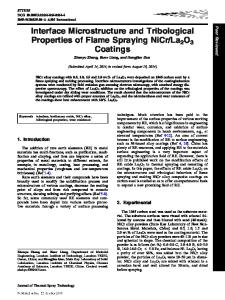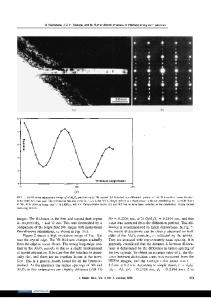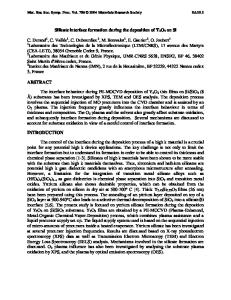Adhesive Properties of the TiAl/Al 2 O 3 Interface
- PDF / 3,749,794 Bytes
- 8 Pages / 595.276 x 790.866 pts Page_size
- 65 Downloads / 351 Views
Russian Physics Journal, Vol. 63, No. 5, September, 2020 (Russian Original No. 5, May, 2020)
CONDENSED-STATE PHYSICS ADHESIVE PROPERTIES OF THE TiAl/Al2O3 INTERFACE A. V. Bakulin,1,2 S. S. Kulkov,2 and S. E. Kulkova1,2
UDC 538.915, 539.612, 544.14
A systematic study of the atomic and electronic structure of the interface between the γ-TiAl alloy and α-Al2O3(0001) oxide depending on the contact configuration is performed within the density functional theory. The work of separation of the alloy film from the oxide surface is calculated for its various terminations. It is shown that high values of adhesion energy can be obtained at the interface with an O-termination of alumina due to the large ionic contribution to chemical bonding. An analysis of structural and electronic factors responsible for the decrease in adhesion at the interface with the metal oxide termination is performed. The calculation of the interfacial energy confirmed that the interface with the O-termination of alumina is energetically preferable. Keywords: interface, adhesion, chemical bonding, electronic structure, density functional theory.
INTRODUCTION Composites based on metals/alloys and oxides have found an extensive application in present-day technologies attracting an increasing interest due to a feasibility of producing materials essentially differing in their properties from their components. Physical-chemical and mechanical properties of composites strongly depend on the characteristics of the oxide-metal interface controlled by their atomic and electronic structure. The knowledge of the electronic structure is necessary for gaining an insight into the nature of chemical bonding at the interfaces and the mechanisms for improving adhesion. Since the phenomena at the interfaces are critical for many engineering processes, they have been quite intensively studied within recent decades by a variety of methods, including the density functional theory, e.g., [1– 13] and references in them. The largest number of works deal with the investigation of the Nb(111)/Al2O3(0001) interface, where a high adhesion energy of ~9.8–10.6 J/m2 was found [2–5, 9, 11], and the interfaces between such fccmetals as Al, Ni, Cu, Ag, Au, etc. and alumina [6–8, 10]. The focus of research is commonly on the interaction of individual atoms or metal monolayers with the oxide surface, which is important for understanding the mechanisms of metal film growth, but would not allow identifying the tendencies in the formation of stable interfaces. Furthermore, during oxidation of metals and alloys, oxide films are observed to grow on their surfaces. This prompts an investigation of the interaction of atomic or molecular oxygen with stable surfaces of metals and alloys, as this was done in a number of studies [14–18]. At present only a few studies are available, where the atomic and electronic structure and mechanical and thermodynamic properties of the alloy-oxide interfaces are discussed; most studies use α-Al2O3 oxide with the corundum structure [19–21]. Since the mechan
Data Loading...











